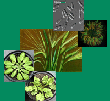| Clemens, S: Toxic metal accumulation, responses to exposure and mechanisms of tolerance in plants, Biochimie, 88, 1707-1719 (2006), doi:10.1016/j.biochi.2006.07.003 | |
| Abstract: Over the past 200 years emissions of toxic heavy metals have risen tremendously and significantly exceed those from natural sources for practically all metals. Uptake and accumulation by crop plants represents the main entry pathway for potentially health-threatening toxic metals into human and animal food. Of major concern are the metalloids arsenic (As) and selenium (Se), and the metals cadmium (Cd), mercury (Hg), and lead (Pb). This review discusses the molecular mechanisms of toxic metal accumulation in plants and algae, the responses to metal exposure, as well as our understanding of metal tolerance and its evolution. The main emphasis will be on cadmium, which is by far the most widely studied of the non-essential toxic metals/metalloids. Entry via Zn2+, Fe2+, and Ca2+ transporters is the molecular basis of Cd2+ uptake into plant cells. Much less is known about the partitioning of non-essential metals and about the genes underlying the enormous diversity among plants with respect to Cd accumulation in different tissues. Numerous studies have described symptoms and responses of plants upon toxic metal exposure. Mysterious are primary targets of toxicity, the degree of specificity of responses, the sensing and the signaling events that lead to transcriptional activation. All plants apparently possess a basal tolerance of toxic non-essential metals. For Cd and As, this is largely dependent on the phytochelatin pathway. Not understood is the molecular biology of Cd hypertolerance in certain plant species such as the metallophytes Arabidopsis halleri or Thlaspi caerulescens. |

